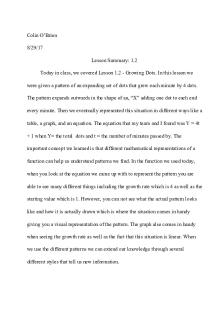Lesson Summary - 1,2 PDF

| Title | Lesson Summary - 1,2 |
|---|---|
| Author | Colin O'Brien |
| Course | Mathematics |
| Institution | University of California, Berkeley |
| Pages | 3 |
| File Size | 54.9 KB |
| File Type | |
| Total Downloads | 10 |
| Total Views | 157 |
Summary
lesson summary...
Description
Colin O’Brien 8/29/17 Lesson Summary: 1.2 Today in class, we covered Lesson 1.2 - Growing Dots. In this lesson we were given a pattern of an expanding set of dots that grew each minute by 4 dots. The pattern expands outwards in the shape of an, “X” adding one dot to each end every minute. Then we eventually represented this situation in different ways like a table, a graph, and an equation. The equation that my team and I found was Y = 4t + 1 when Y= the total dots and t = the number of minutes passed by. The important concept we learned is that different mathematical representations of a function can help us understand patterns we find. In the function we used today, when you look at the equation we came up with to represent the pattern you are able to see many different things including the growth rate which is 4 as well as the starting value which is 1. However, you can not see what the actual pattern looks like and how it is actually drawn which is where the situation comes in handy giving you a visual representation of the pattern. The graph also comes in handy when seeing the growth rate as well as the fact that this situation is linear. When we use the different patterns we can extend our knowledge through several different styles that tell us new information.
One other important lesson from today’s class was the use of recursive equations. Recursive equations are different from what we usually see, which are explicit equations. Explicit equations are designed and used for functions whereas recursive equations are for sequences. In the situation given in Lesson 1.2, the explicit equation would be Y = 4t + 1 where Y = the total number of dots and t = the number of minutes passed by. The recursive equation is f(t) = f(t - 1) + 4 where f(t) = the current minute and stage that you are in and f(t - 1) = the previous stage. f(t) stands for a function of t (time). A function of t is also another way of saying Y, the total number of dots. Therefore, Y = f(t). This is function notation which is just another way of writing out and representing a function. f(t) is helpful because it can provide more information like what t is equal to. The major disadvantage of a recursive equation is that you can only find the value of the next stage but nothing else. For example, if I wanted to know how many dots there would be at minute 100, I could simply substitute 100 for t in the explicit equation to simplify and have Y = 401 dots. But if I wanted to use the recursive equation I would have to solve each level of dots one by one until I got to 100 minutes because without the knowledge of the previous stage, 99 minutes, you can’t simplify the equation. In Lesson 1.2 we learned a few important vocabulary words. First, we learned about arithmetic sequences which is a sequence of numbers with a
common difference between them. For example, in the the situation in the lesson, there is a growth rate of 4 dots per minute. This means that at 0 minutes there was a starting value of 1 dot. Then at 1 minute there were 5 dots. Then at 2 minutes there were 9 dots, etc. Since the difference between any two values is the same amount (4) this is an arithmetic sequence....
Similar Free PDFs

Lesson 12 - FL
- 4 Pages

Lesson 12 - Cheliceriformes
- 3 Pages

Lesson 12 - Group Dynamics
- 3 Pages

Lesson 12 Essay Activity
- 2 Pages

Lesson 2 Reading Summary
- 2 Pages

Lesson Summary - 3.1
- 2 Pages

Lesson Summary - 1.5
- 3 Pages

Lesson Summary - 6.1
- 2 Pages

Articles Summary - Lesson 4
- 4 Pages

Lesson Summary - 2.2
- 3 Pages

Lesson Summary - 4.1
- 2 Pages

Lesson Summary - 7.5
- 3 Pages

Lesson Summary - 1,2
- 3 Pages

Reading Summary Lesson 1
- 1 Pages

Pcubsa Assignment 1 Lesson 12
- 9 Pages

FREN 202 Lesson 12 - notes
- 7 Pages
Popular Institutions
- Tinajero National High School - Annex
- Politeknik Caltex Riau
- Yokohama City University
- SGT University
- University of Al-Qadisiyah
- Divine Word College of Vigan
- Techniek College Rotterdam
- Universidade de Santiago
- Universiti Teknologi MARA Cawangan Johor Kampus Pasir Gudang
- Poltekkes Kemenkes Yogyakarta
- Baguio City National High School
- Colegio san marcos
- preparatoria uno
- Centro de Bachillerato Tecnológico Industrial y de Servicios No. 107
- Dalian Maritime University
- Quang Trung Secondary School
- Colegio Tecnológico en Informática
- Corporación Regional de Educación Superior
- Grupo CEDVA
- Dar Al Uloom University
- Centro de Estudios Preuniversitarios de la Universidad Nacional de Ingeniería
- 上智大学
- Aakash International School, Nuna Majara
- San Felipe Neri Catholic School
- Kang Chiao International School - New Taipei City
- Misamis Occidental National High School
- Institución Educativa Escuela Normal Juan Ladrilleros
- Kolehiyo ng Pantukan
- Batanes State College
- Instituto Continental
- Sekolah Menengah Kejuruan Kesehatan Kaltara (Tarakan)
- Colegio de La Inmaculada Concepcion - Cebu